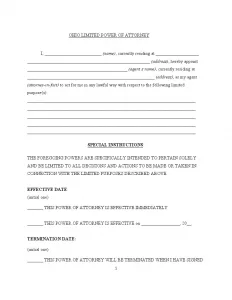Ohio Limited Power of Attorney Form
The Ohio limited power of attorney grants someone else the authority to act on your behalf for specific, clearly defined tasks or events. This legal tool helps handle particular financial transactions or make decisions about property when you can’t be present to do so yourself.
Contrary to a general power of attorney, which grants broad powers, a limited power of attorney limits the agent’s role to specific activities explicitly stated in the document. Examples include the sale of property, the management of certain assets, or the handling of tax matters. The limited power of attorney automatically terminates when the specified task is completed, ensuring that control remains tightly regulated.
Use our Ohio power of attorney forms when you need a reliable way to manage your legal and financial responsibilities.

Build Your Document
Answer a few simple questions to make your document in minutes
Save and Print
Save progress and finish on any device, download and print anytime
Sign and Use
Your valid, lawyer-approved document is ready
In Ohio, the creation of a limited power of attorney is strictly regulated under Chapter 1337 of the Ohio Revised Code. The law defines a “power of attorney” as any written or recorded document that delegates authority from a principal to an agent, allowing the latter to act in the principal’s stead. This authority remains effective whether the term “power of attorney” is explicitly used or not. Requirements for signing a limited power of attorney in Ohio include:
- Clear grant of authority. The document must specify the exact powers being transferred.
- Notarization. The signature of the principal must be acknowledged before a notary public.
These steps ensure the document’s validity and enforceability, preventing misunderstandings and unauthorized actions.
Ohio Limited Power of Attorney Form Details
| Document Name | Ohio Limited Power of Attorney Form |
| Other Name | Ohio Special Power of Attorney |
| Relevant Laws | Ohio Revised Code, Section 1337.34 |
| Avg. Time to Fill Out | 8 minutes |
| # of Fillable Fields | 32 |
| Available Formats | Adobe PDF |
Filling Out Ohio Limited POA
Follow these detailed steps to complete the Ohio limited power of attorney form, ensuring the document meets legal standards and accurately reflects your intentions.
1. Fill in the Principal’s Name
Start by entering your full name (as the principal) in the space provided at the beginning of the form, indicating that you are appointing someone as your attorney-in-fact.
2. Appoint Your Attorney-in-Fact
Write the full name of the person you are appointing as your attorney-in-fact. This individual will have the authority to act on your behalf as specified in the document.
3. Detail the Powers
Clearly describe the specific powers you grant to your attorney in the space provided. These might include the power to sell property, manage financial accounts, or handle business transactions. Be as precise as possible to avoid any ambiguity.
4. Sign the Document
Once the powers have been clearly defined, sign the form in the designated area to affirm your decision to grant these powers.
5. Presence of Witnesses
Ensure the form is signed in the presence of at least one witness who is not the attorney-in-fact. The witness should observe you signing the document.
6. Notarize the Form
Take the signed form to a notary public for notarization. The notary will verify your identity and signature before affixing the stamp and completing the acknowledgment section, confirming that you indeed signed the form.
7. Provide Copies to Relevant Parties
After notarization, provide copies of the completed form to your attorney-in-fact and any institutions or individuals who will interact with the attorney-in-fact under this power of attorney. Keep the original in a safe place.
